Effective Strategies to Combat Sawtoothed Grain Beetles


Intro
Sawtoothed grain beetles can present a significant challenge for homeowners, especially in areas where food storage is key. Understanding these pests, their behavior, and how to effectively manage them can save time, money, and stress. This guide aims to equip you with detailed knowledge on identifying these beetles, their life cycle, and how to implement effective control measures.
Understanding the Pest
Identification
The sawtoothed grain beetle, scientifically named Oryzaephilus surinamensis, is a common pest found in stored products. It is easily recognized by its distinctive sawtoothed appearance on the thorax, which features six prominent serrations on each side. Adult beetles are approximately 2.5 to 3 mm long, and their color ranges from light brown to dark brown.
In addition to the adult beetles, their larvae are also a concern. These larvae are cream-colored, segmented, and often difficult to spot without close inspection.
Identifying the sawtoothed grain beetle at an early stage is crucial for effective management.
Life Cycle
Understanding the life cycle of the sawtoothed grain beetle helps in crafting effective control strategies. Their life cycle consists of four stages:
- Egg: Female beetles lay eggs in tiny clusters near food sources.
- Larva: After hatching, larvae feed on grains or stored products, growing for about 2-3 weeks.
- Pupa: They then develop into pupae, where they undergo transformation.
- Adult: Upon emerging as adults, they can live for several months, continuing the cycle by laying more eggs.
This life cycle highlights the need for ongoing vigilance, as a single infestation can lead to significant damage if not addressed promptly.
Pest Prevention Strategies
Environment Modification
Preventing sawtoothed grain beetles involves first modifying the environment in which food is stored.
- Eliminate Clutter: Keeping storage areas tidy helps limit hiding spaces.
- Maintain Temperature: Store grains and other food items in cool, dry places. Higher temperatures promote beetle reproduction.
- Seal Cracks: Use caulk or filler to seal any cracks in storage areas, preventing beetles from entering.
Physical Barriers
Physical barriers can serve as an effective deterrent against sawtoothed grain beetles.
- Airtight Containers: Store food in airtight glass or plastic containers to prevent access.
- Regular Inspection: Examine food products regularly for signs of infestation, such as webbing or the presence of larvae.
Control Methods
Chemical Control
When prevention strategies fail, chemical control becomes necessary. Always follow the instructions provided by the manufacturer to ensure safety and effectiveness. Some recommended options include:
- Insecticides: Products like pyrethrins or permethrin can be effective in managing infestations. Always follow label directions.
- Fumigation: For larger infestations, consider professional fumigation services to eliminate beetles.
Biological Control
Biological control may not be as widely used but can be a part of an integrated pest management plan. Natural predators and parasites exist that can help keep beetle populations in check.
- Beneficial Nematodes: These microscopic organisms can infect and kill beetle larvae.
- Insect Pathogenic Fungi: Some fungi specifically target grain beetles and can be an alternative control method.
Combining these approaches creates a robust strategy against sawtoothed grain beetles, ensuring that your home remains pest-free.
Preamble to Sawtoothed Grain Beetles
Sawtoothed grain beetles are a troublesome pest, primarily found in stored food products. Recognizing their presence early is vital for effective management. This section will provide insights into understanding what these pests are, their characteristics, and why managing their infestation is significant for homeowners and businesses alike.
Understanding the Pest
Sawtoothed grain beetles, known scientifically as Oryzaephilus surinamensis, belong to the family Silvanidae. These pests are relatively small, measuring about 2.5 to 3 mm in length. They possess a distinctive shape, with a flattened body and six sawtooth-like projections on each side of their thorax. This uniqueness in physical appearance makes them easily identifiable in stored products.
These beetles tend to invade various types of food items, especially grains, cereals, nuts, and dried fruits. They can also infest pet food and flour. As they feed on these products, they create a significant mess, leading to unhygienic conditions. Their ability to reproduce quickly compounds the problem, making them a persistent concern in households and commercial establishments.
Knowing their habits and behaviors is essential. Sawtoothed grain beetles are nocturnal creatures, primarily active at night. They prefer warmer, humid environments, which makes kitchens and pantries prime locations for infestations. Regular inspections of these areas can help catch infestations before they become severe.
Significance of Management
Effective management of sawtoothed grain beetles is crucial for several reasons. First, their presence can lead to contamination of food, leading to waste and potential health risks. Infested food often has to be discarded, which can be costly both for households and businesses.
Moreover, allowing these pests to flourish can undermine the integrity of stored products. Restaurants, food distributors, and manufacturers face challenges when dealing with pest infestations. Maintaining cleanliness and safety is not only a regulatory requirement but also impacts customer satisfaction and brand reputation.
"Early detection and management of sawtoothed grain beetles can save both money and resources, preventing larger infestations later."
Additionally, many consumers today are increasingly environmentally sensitive. They seek solutions that are safe for the home and do not rely heavily on harmful pesticides. Understanding effective management methods, including safe and natural control options, provides valuable insights that can lead to sustainable practices.
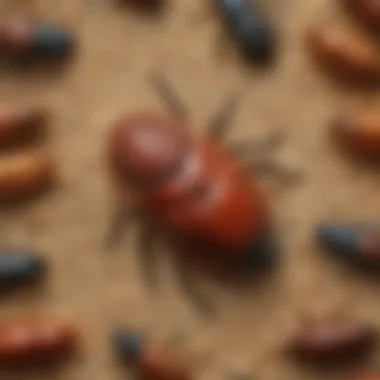
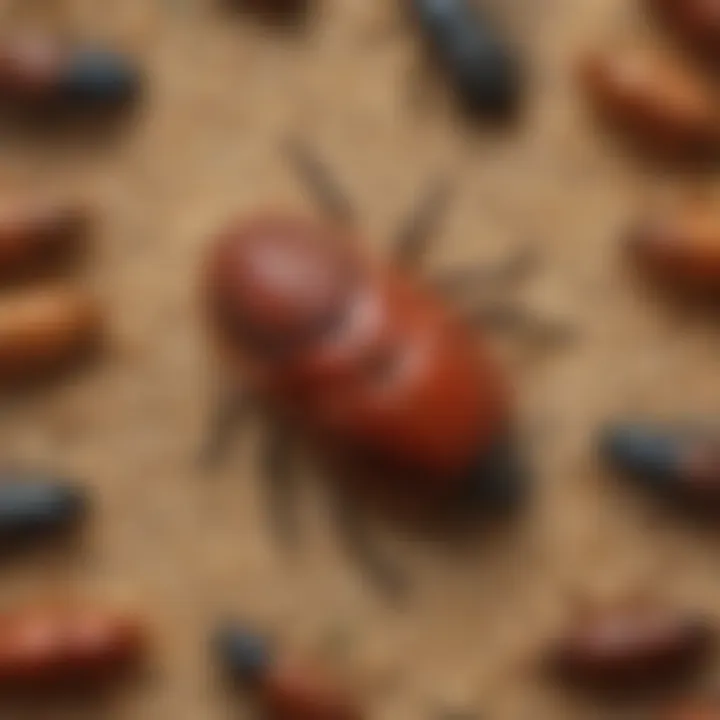
By recognizing the significance of controlling sawtoothed grain beetles, homeowners can take proactive steps in pest management. This awareness helps to not only protect food but also maintain a clean living environment.
Identification of Sawtoothed Grain Beetles
Understanding how to identify sawtoothed grain beetles is crucial for managing infestations effectively. Proper identification allows homeowners to take timely action to mitigate damage. These pests thrive in specific environments and have unique characteristics that distinguish them from other pests. Recognizing the physical traits, preferred habitats, and signs of infestation can save both time and resources in handling these unwanted visitors.
Physical Characteristics
Sawtoothed grain beetles are small, measuring about 2.5 to 3.5 mm in length. They have flat bodies with a reddish-brown color, making them somewhat inconspicuous. A notable feature is the 6 serrated spikes that line each side of their thorax, giving them the name "sawtoothed." Their elongated shape and the shiny appearance further help in identifying them. Unlike other pests, they do not have prominent antennae. Instead, their antennae are slender and segmented, which differentiates them from similar beetles.
Being familiar with these characteristics aids in recognizing infestations early.
Common Habitats
Sawtoothed grain beetles prefer environments rich in grains and processed food products. They are commonly found in areas where grains, such as wheat and corn, are stored. Kitchen pantries, bakeries, and warehouses are typical locations for finding these pests.
Notably, they thrive in warm and humid conditions. As such, they may be more prevalent in regions with high humidity levels. Their ability to travel through various food products makes it vital to check for their presence, especially in stored items. Regular inspections can help ascertain if these pests have taken up residence.
Signs of Infestation
Detecting a sawtoothed grain beetle infestation early on is key to preventing further damage. One of the first signs is the presence of live beetles in food storage areas. Additionally, their larvae, which are creamy white with a slightly darker head, may also be spotted in infested products.
Other indicators include:
- Webbing or silk-like material found in food containers.
- Frass, which looks like small grains of rice, scattered near infested items.
- Damage to food products, including holes and contamination.
Early detection is essential for managing sawtoothed grain beetles. Ignoring initial signs can lead to larger infestations that are harder to control.
In summary, knowing how to identify sawtoothed grain beetles significantly impacts a homeowner's ability to manage and eliminate these pests. Proper identification leads to swift action, thus limiting damage and making pest control efforts more effective.
Life Cycle of Sawtoothed Grain Beetles
Understanding the life cycle of sawtoothed grain beetles is crucial for effective pest management. Each stage of their development presents unique vulnerabilities and opportunities for control. By comprehending these phases, homeowners can enhance their strategies in preventing infestations and mitigating damage.
Egg Stage
The life cycle begins when a female beetle lays eggs, usually in clustered groups. Each female can produce from 50 to 300 eggs during her lifespan. These eggs are tiny, measuring about 0.5 mm, and are typically deposited in areas where food sources are prevalent, like grains and cereals. The incubation period lasts approximately one week under optimal conditions. At this stage, monitoring places where food is stored can be highly effective.
Larval Development
Once the eggs hatch, the larvae emerge. Larval development can take around two to three weeks, depending on environmental factors. The larvae, which are worm-like, feed on food materials and can cause significant damage. They can live in various substrates, including flour, rice, and other stored products. It is essential to conduct thorough inspections of food storage areas during this time. Removing infested materials will help in limiting their growth.
Adult Stage
After the larval stage, the insects emerge as adults. Adult sawtoothed grain beetles have a flattened body, about 2.5 to 3 mm long, with six distinctive saw-like projections along each side of their bodies. They are able to reproduce quickly and can live for several months. Their presence indicates a well-established infestation. Adults are capable of flying, which means they can easily spread to new areas and products, making regular checks on food sources necessary.
"Understanding the life cycle is key to controlling sawtoothed grain beetles effectively. Each stage offers a window for intervention and prevention."
In summary, the life cycle plays a vital role in the overall approach to managing sawtoothed grain beetle infestations. By knowing when and where to act, you can significantly reduce their population and protect stored food.
Methods for Eliminating Sawtoothed Grain Beetles
Eliminating sawtoothed grain beetles involves a strategic approach that combines multiple methods tailored to the specific needs of the environment and severity of the infestation. This section outlines key techniques to manage these pests effectively, ensuring a clean and safe living space. Understanding the methods available empowers homeowners, enabling them to choose the most effective solution based on their situation.
Physical Removal
Physical removal is often the first line of defense against sawtoothed grain beetles. This method is straightforward and requires minimal resources. By identifying and removing infested items, a homeowner can significantly reduce the population of these pests.
- Inspect food storage areas regularly.
- Vacuum or sweep to remove beetles and their eggs.
- Dispose of infested food items immediately.
It is important to focus on food packages that are damaged or compromised. Discarding infected grains helps prevent the population from growing and spreading. This strategy is beneficial for health and also reduces any unpleasant presence of these insects in the kitchen.
Chemical Control Options
Chemical control options should be considered when physical removal is not enough to eliminate the pests entirely. There are various pesticides available specifically designed to target grain beetles. It is critical to select products that are labeled for indoor use and are safe for food preparation areas.
Here are some important aspects to consider:
- Select a pesticide registered with the Environmental Protection Agency (EPA).
- Follow the application instructions carefully to minimize health risks.
- Consider using baits or sprays that target the adult beetles and their larvae.
Always remember to store chemical products safely and out of reach of children or pets. Proper usage can help achieve effective control but must be approached with caution.
Natural Alternatives
Natural alternatives provide an eco-friendly solution for those who prefer to avoid harsh chemicals. These options can be effective and safe for households, especially with young children or pets.
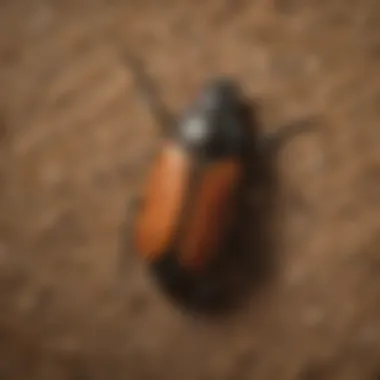
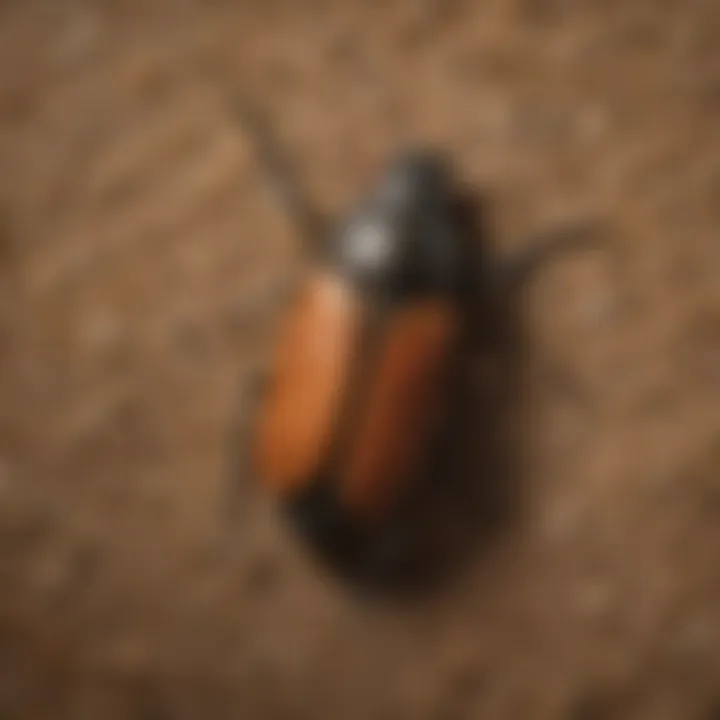
Some effective methods include:
- Diatomaceous Earth: Spread this natural powder in areas where beetles are active. It is safe for humans but deadly for insects.
- Essential Oils: Oils such as peppermint or tea tree can repel beetles due to their strong scents. Dilute in water and spray around infested areas.
- Bay Leaves: Placing bay leaves in food storage can deter these pests since beetles dislike the smell.
Natural methods can be less effective in high-infestation situations, but they provide a good option for preventing new infestations.
Consider integrating several methods for comprehensive management. A combination of physical, chemical, and natural solutions may yield the best results.
In summary, evaluating the specific context and severity of the infestation is key. Homeowners must weigh the efficacy, safety, and practicality of each method before implementation.
Implementing Control Strategies
Implementing control strategies is vital when managing sawtoothed grain beetle infestations. This helps not only in addressing existing problems but also in preventing further outbreaks. A well-thought-out plan increases the effectiveness of the methods used. Failing to implement these strategies may lead to persistent issues, resulting in financial losses and damage to food products. It is essential to adopt a systematic approach.
Creating an Effective Plan
To begin with, creating an effective plan is a structured process that includes several key components. The first step is identifying the extent of the infestation. This involves monitoring for signs of the sawtoothed grain beetles. Once the scope is understood, setting clear objectives is essential. Objectives might range from complete eradication to simply reducing the pest population to manageable levels.
Key elements to include in the plan:
- Thorough Inspection: Regular checks of food storage areas and other potential breeding sites are necessary.
- Resource Allocation: Ensure that you have appropriate resources, including traps, insecticides, or natural repellents.
- Timeline: Establish deadlines for each phase of the control strategy. A schedule helps maintain focus and motivation.
- Documentation: Keeping records of activities helps track progress and adjust strategies as needed.
By ensuring all factors are considered, the plan can adapt to changing circumstances and yield better results.
Monitoring Progress
Monitoring progress is another crucial aspect of implementing control strategies. It provides valuable insight into how effective your actions are against the sawtoothed grain beetles. Consistency in monitoring will reveal if the infestation is decreasing or continues to persist.
Some effective methods for monitoring include:
- Regular Observations: Check traps and other monitoring tools frequently to assess activity.
- Record Changes: Document any changes in beetle sightings or damage to food products. This information is pivotal in evaluating the effectiveness of applied strategies.
- Adjusting Measures: If monitoring indicates that certain strategies are not yielding results, adjustments may be necessary. This could involve changing insecticides or enhancing sanitation practices.
Setting specific timelines for monitoring can create accountability. For example, reviews could occur weekly or bi-weekly, depending on the severity of the infestation.
"A systematic approach ensures that all aspects of the pest control plan are covered, leading to more effective outcomes."
Preventive Measures to Avoid Infestations
Preventing sawtoothed grain beetle infestations is essential for maintaining a pest-free environment in homes and food storage areas. These pests can cause damage to grains and stored foods, leading to financial losses, health concerns, and food waste. By implementing effective preventive measures, homeowners can mitigate the risk of infestation before it occurs.
Proper Food Storage
Proper food storage is a key factor in preventing sawtoothed grain beetles. They thrive in environments where food items, especially grains, are readily available. Here are some essential practices to consider:
- Use airtight containers: Storing food in airtight, durable plastic or glass containers can help deter beetles from accessing food sources.
- Keep food areas dry: Moist environments attract pests. Ensure that pantry and storage areas are well-ventilated and dry. Consider using silica gel packs or moisture-absorbing products.
- Label and rotate stock: Regularly check and rotate stored food to keep older items used first. This helps minimize the risk of any potential insect presence.
By adopting keen food storage habits, individuals can greatly reduce the chances of an infestation taking hold.
Regular Cleaning Practices
Regular cleaning practices are another cornerstone of preventive upkeep. An environment kept clean is less likely to attract pests. Here are some key considerations:
- Frequent vacuuming: Vacuuming pantry shelves, corners, and floors can remove any leftover food particles that may attract beetles.
- Dispose of spills immediately: Any spills should be cleaned as soon as they occur to avoid drawing pests.
- Use natural cleaning solutions: Opt for non-toxic cleaners that do not leave residues which may inadvertently attract insects.
Incorporating these cleaning habits will not only deter sawtoothed grain beetles but also enhance the overall cleanliness of the home.
Inspections of Incoming Products
Inspections of incoming products play a crucial role in prevention. Thoroughly checking food and product deliveries can identify potential sources of infestation before they enter the home. Here’s how to effectively execute inspections:
- Examine packaging: Check any packaging for signs of pest damage or holes before bringing it inside.
- Look for adult pests or larvae: If any suspicious items are found, dispose of them immediately to avoid introducing pests into your environment.
- Maintain records of products: Keeping a checklist or inventory of products can help track goods and keep tabs on their origins.
Taking these proactive steps can substantially minimize the risk of bringing contaminated items into a home.
"Prevention is always better than cure. The same principle applies to pest management."
In summary, implementing preventive measures such as proper food storage, regular cleaning practices, and thorough inspections of incoming products can significantly reduce the likelihood of sawtoothed grain beetle infestations. These strategies not only protect stored foods but also contribute to a healthier and more pleasant living environment.
Impact of Climate and Environment
Understanding the impact of climate and environment on sawtoothed grain beetles is essential for effective management. Environmental conditions play a significant role in their growth, reproduction, and behavior. By studying these factors, homeowners can develop proactive strategies to control infestations more effectively. The interplay of temperature, humidity, and seasonal changes greatly affects how and when these pests thrive. Furthermore, it also helps in determining when particular intervention techniques should be applied to suppress their populations.
Influence of Temperature and Humidity
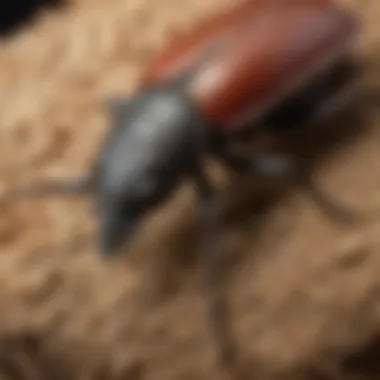
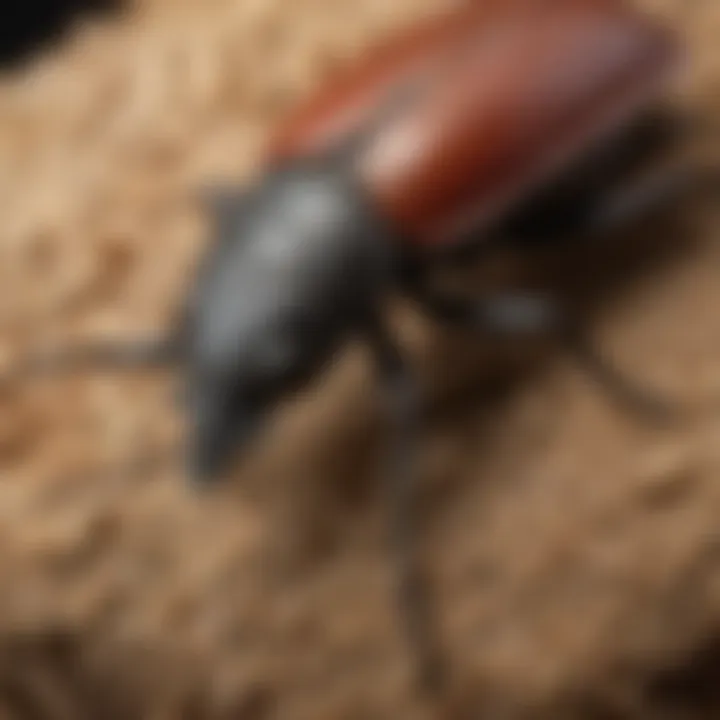
Temperature and humidity are crucial factors influencing the life cycle of sawtoothed grain beetles. These pests prefer warm, humid environments, which facilitate their reproduction and development. Generally, temperatures between 70°F and 90°F (21°C to 32°C) are optimal for their growth. When humidity levels rise, particularly above 60%, the pests reproduce more rapidly, leading to an escalation in population density.
Homeowners must monitor these conditions, especially in storage areas. Implementing climate control measures can hinder beetle development. For instance, using dehumidifiers or air conditioning to maintain lower humidity can effectively slow their reproduction. Additionally, areas that have frequent fluctuations in temperature and humidity can create stress in beetle populations, sometimes leading to their decline.
Role of Seasonal Changes
Seasonal variations also have a significant impact on sawtoothed grain beetles. In cooler months, these beetles may become less active or seek shelter in warmer storage areas. This tendency makes it important to conduct regular inspections during the fall and winter seasons.
As spring approaches and temperatures rise, beetles emerge from their dormant state, leading to an increase in activity. This is usually the time when infestations are most common. Thus, homeowners should be proactive in their pest management strategies at the onset of warmer weather.
Implementing preventive measures at this stage can minimize infestations. Inspections of stored grains at intervals will also help catch beetles early.
Regular monitoring during seasonal shifts helps identify infestations before they escalate into a larger issue.
Understanding these environmental influences can provide significant benefits. By aligning pest management strategies with climate conditions, more effective control can be achieved.
Collaboration with Pest Control Professionals
When facing an infestation of sawtoothed grain beetles, collaboration with pest control professionals is crucial. These specialists bring expertise and resources that can enhance the effectiveness of any management plan. They can conduct thorough inspections, identify problem areas, and implement appropriate control strategies that might be overlooked by a layperson.
Additionally, pest control professionals are informed about the latest techniques and products that are both effective and environmentally safe. This knowledge is vital, particularly for those who prioritize sustainable practices in their pest management approach. They can also provide insights into the life cycle of these pests, assisting in developing a strategy that targets specific stages effectively.
When to Call a Professional
It is essential to know when to call a pest control expert. Here are some key indicators:
- Severe Infestation: If the presence of sawtoothed grain beetles becomes overwhelming and home remedies fail, a professional can address the issue promptly.
- Persistent Problems: If you notice recurring infestations despite following preventive measures, it might indicate deeper issues that require professional intervention.
- Health Concerns: For those with allergies or sensitivities, professional assistance can minimize risks and ensure safe application of treatments.
Enlisting the help of a pest management expert is especially important when you feel overwhelmed or uncertain about the next steps to take.
Choosing the Right Service
Selecting the right pest control service is critical for effective management. Here are some factors to consider:
- Experience and Expertise: Look for companies that specialize in grain pests. Their knowledge can lead to better detection and removal strategies.
- Methods and Products: Verify the types of treatments they use. Sustainable and low-toxicity products should be preferred to minimize impact on the environment.
- Customer Reviews: Past customer experiences can reveal the reliability and effectiveness of the service. Check platforms such as Reddit or Facebook for feedback from your local community.
In summary, the collaboration with pest control professionals optimizes your approach to eliminating sawtoothed grain beetles, making it essential to recognize when assistance is needed and how to choose the right partner.
Case Studies and Success Stories
Case studies provide real-world examples of effective strategies for managing sawtoothed grain beetle infestations. They showcase diverse approaches and outcomes, offering valuable insights for homeowners and pest control professionals alike. By examining successful interventions, one can identify best practices and pitfalls to avoid.
Such narratives illustrate how integrated control methods generate results, emphasizing the relevance of adaptive strategies in various contexts. Consideration of case studies can lead to greater awareness of the factors driving infestations and effective remediation techniques.
Residential Successes
In residential settings, homeowners encountered a surge in sawtoothed grain beetles due to poor storage practices. After identifying the infestation, one household implemented a series of strategic measures. They began by cleaning every corner of their kitchen and pantry, removing all infested food items and thoroughly vacuuming spaces to eliminate any eggs.
Next, the family opted for airtight containers to store grains and cereals securely. This small change dramatically reduced the number of beetles by denying them a food source and a breeding ground. Regular inspections became a routine part of their household maintenance. This proactive approach not only addressed the immediate problem but also instilled preventive habits that contributed to long-term success.
A second residential case emphasized the importance of collaboration with pest control professionals. By working with experts who identified entry points and breeding areas, this family managed to eliminate the infestation more effectively than self-treatment. The professional's knowledge provided insights not just about their immediate problem, but also educational resources on ongoing management and prevention.
Commercial Achievements
Commercial operations, such as warehouses and food processing plants, also face significant challenges from sawtoothed grain beetles. In one notable case, a grain distributor observed a spike in complaints regarding pest presence. The management team initiated a comprehensive pest management plan as a response.
This plan included an extensive audit of their facility, followed by structural improvements to seal off potential entry points. They implemented a strict routine for cleaning and sanitation, focusing on areas prone to food accumulation. Furthermore, the distributor began using effective traps and monitors to gauge beetle activity over time, leading to informed decisions regarding pesticide applications when necessary.
Success in industry settings also hinged on employee training. Workers were educated on how to identify signs of infestations and the significance of maintaining cleanliness. By engaging the entire workforce in pest prevention, a sense of accountability emerged, fostering an environment where pests had little chance to thrive.
In summary, both residential and commercial case studies illustrate how targeted actions yield substantial benefits. These examples serve as proof that with diligence, knowledge, and the right strategies, eliminating sawtoothed grain beetle infestations is attainable.
End
The conclusion serves as a critical component of any comprehensive resource. It synthesizes the knowledge provided throughout the article, reiterating the importance of understanding and managing sawtoothed grain beetle infestations. Recognizing these pests is only the first step. The article's detailed exploration of their life cycle, identification, and control methods equips homeowners and pest management professionals with the necessary tools to address this issue effectively.
Throughout the article, various strategies for eliminating these beetles have been presented. This encapsulation clarifies the significance of proactive measures, including proper food storage and timely inspections of incoming products. The insights shared aim to empower readers to take informed actions, thus reducing the risk of future infestations. Understanding the key elements—identification, control, and prevention—ensures long-term management success.
"The best defense against pests like the sawtoothed grain beetle is an informed and prepared homeowner."
This section underscores not only the immediate benefits of pest control but also the broader implications it has for overall home hygiene and safety.
Summary of Key Points
- Identification: Knowing the physical characteristics and signs of infestation is critical.
- Life Cycle: Understanding the life stages helps in targeted control efforts.
- Control Methods: Various strategies, including physical, chemical, and natural methods, are available.
- Prevention: Implementing preventive measures is essential to avoid future infestations.
- Professional Help: Recognizing when to engage pest control professionals can lead to more effective outcomes.
Final Recommendations
- Maintain a Clean Environment: Regular cleaning reduces potential breeding grounds for beetles.
- Secure Food Sources: Store all food in airtight containers.
- Conduct Frequent Inspections: Regular checks will catch infestations before they escalate.
- Consider Natural Remedies: Explore natural control options that are less harmful to the environment.
- Engage Professionals When Needed: If infestations persist, contacting a pest control service can provide tailored solutions.
By prioritizing these recommendations, homeowners can effectively manage sawtoothed grain beetle issues, ensuring a healthy living space.







